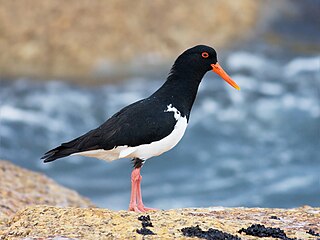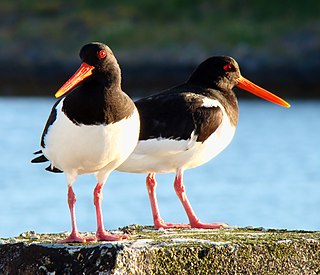
The oystercatchers are a group of waders forming the family Haematopodidae, which has a single genus, Haematopus. They are found on coasts worldwide apart from the polar regions and some tropical regions of Africa and South East Asia. The exceptions to this are the Eurasian oystercatcher, the South Island oystercatcher, and the Magellanic oystercatcher, which also breed inland, far inland in some cases. In the past there has been a great deal of confusion as to the species limits, with discrete populations of all black oystercatchers being afforded specific status but pied oystercatchers being considered one single species.

The black currawong, also known locally as the black jay, is a large passerine bird endemic to Tasmania and the nearby islands within the Bass Strait. One of three currawong species in the genus Strepera, it is closely related to the butcherbirds and Australian magpie within the family Artamidae. It is a large crow-like bird, around 50 cm (20 in) long on average, with yellow irises, a heavy bill, and black plumage with white wing patches. The male and female are similar in appearance. Three subspecies are recognised, one of which, Strepera fuliginosa colei of King Island, is vulnerable to extinction.

The pied currawong is a black passerine bird native to eastern Australia and Lord Howe Island. One of three currawong species in the genus Strepera, it is closely related to the butcherbirds and Australian magpie of the family Artamidae. Six subspecies are recognised. It is a robust crowlike bird averaging around 48 cm (19 in) in length, black or sooty grey-black in plumage with white undertail and wing patches, yellow irises, and a heavy bill. The male and female are similar in appearance. Known for its melodious calls, the species' name currawong is believed to be of indigenous origin.

The Eurasian oystercatcher also known as the common pied oystercatcher, or palaearctic oystercatcher, or just oystercatcher, is a wader in the oystercatcher bird family Haematopodidae. It is the most widespread of the oystercatchers, with three races breeding in western Europe, central Eurosiberia, Kamchatka, China, and the western coast of Korea. No other oystercatcher occurs within this area. The extinct Canary Islands oystercatcher, formerly considered a distinct species, may have actually been an isolated subspecies or distinct population of the Eurasian oystercatcher.

The African oystercatcher or African black oystercatcher, is a large charismatic wader resident to the mainland coasts and offshore islands of southern Africa. This near-threatened oystercatcher has a population of over 6,000 adults, which breed between November and April. The scientific name moquini commemorates the French naturalist Alfred Moquin-Tandon who discovered and named this species before Bonaparte.

The black oystercatcher is a conspicuous black bird found on the shoreline of western North America. It ranges from the Aleutian Islands of Alaska to the coast of the Baja California peninsula.

The pied oystercatcher is a species of oystercatcher. It is a wading bird native to Australia and commonly found on its coastline. The similar South Island pied oystercatcher occurs in New Zealand.

The Chatham oystercatcher or Chatham Island oystercatcher is a species of oystercatcher. It is a wading bird endemic to the Chatham Islands, New Zealand. This species is rated by the IUCN as endangered, and has a current population of 310 to 325 birds. The main threat is from introduced predators.

The Canary Islands oystercatcher, Canarian oystercatcher, or Canarian black oystercatcher , was a shorebird of uncertain taxonomy endemic to Fuerteventura, Lanzarote, and their offshore islets in the Canary Islands, Spain. It is now considered to be extinct.

The weebill is a species of bird in the family Acanthizidae. It is an insectivorous passerine that is found throughout mainland Australia. At 8 to 9 cm long, it is Australia's smallest bird. It was originally described by John Gould in 1838, and four subspecies are recognised. The weebill's plumage is nondescript, with olive-grey upperparts and paler, more yellowish underparts. It grades from more brownish plumage in the southern regions of Australia to more yellow in tropical areas.

The South Island oystercatcher or South Island pied oystercatcher is one of the two common oystercatchers found in New Zealand. Its name is often contracted to the acronym "SIPO". The indigenous Māori name is tōrea. The scientific name commemorates the German ethnographer, naturalist and colonial explorer Friedrich Hermann Otto Finsch.

The inland dotterel is an endemic shorebird of the arid Australian interior. It forms loose flocks in sparsely vegetated gibber plain and claypans in the day where it loafs in the shade and eats shoots of shrubs. It is most often encountered at night when it forages on roads for insects. The relative remoteness of its habitat means that it is not well studied. The most detailed observations of the species were made by the South African arid-zone ornithology specialist Gordon Maclean in the 1970s. Alternate English names include Australian plover, inland plover, desert plover and prairie plover.

The variable oystercatcher is a species of wader in the family Haematopodidae. It is endemic to New Zealand. The Maori name is torea-pango. They are also known as 'red bills'.

The black-backed butcherbird is a species of bird in the family Artamidae. It is found in southern New Guinea and Cape York Peninsula.

The red-headed myzomela or red-headed honeyeater is a passerine bird of the honeyeater family Meliphagidae found in Australia, Indonesia, and Papua New Guinea. It was described by John Gould in 1840. Two subspecies are recognised, with the nominate race M. e. erythrocephala distributed around the tropical coastline of Australia, and M. e. infuscata in New Guinea. Though widely distributed, it is not abundant within this range. While the IUCN lists the Australian population of M. e. infuscata as being near threatened, as a whole the widespread range means that its conservation is of least concern.

The Australian pratincole is a species of bird in the family Glareolidae. It breeds in Australia's interior; it winters to northern and eastern parts of the continent, Indonesia and New Guinea. It is a medium-sized nomadic shorebird which is commonly found in arid inland Australia. It breeds predominantly from south-western Queensland to northern Victoria and through central Australia to the Kimberley region in Western Australia. The Australian population is estimated at 60,000 individuals. They are a migratory species that generally move to the southern parts of their distribution range to breed during spring and summer. During winter they migrate to northern Australia, New Guinea, Java, Sulawesi and southern Borneo to over-winter. Although they are common, their occurrence is unpredictable and varies in location.


















